

This season has been a good one for UK cherries.....lots of beautiful fruit, spread over a season which lasted for 10 weeks....now UK Apples & Pears will take centre stage....broadly speaking the cherry season starts with harvest in East Kent and finishes with cherries in Scotland..........
Before reporting on the advancing UK apple & pear season: In late July, The English Apple Man visited Lower Hope Fruit Farm in Herefordshire, one of the later cropping UK cherry farms.
Lower Hope Fruit is part of the 2,000 acre Lower Hope Estate owned by Clive Richards who bought the estate in 1985: the Fruit Farm was managed for 28 years by Andy Hunt who was highly respected in the industry for his development of cherry production at Lower Hope. Andy retired last year and his Assistant Manager - Emily Livesey became Manager of the fruit farm.
Lower Hope Fruit Farm had been a fairly traditional fruit farm, growing apples and still grows Bramleys and Opal apples. Lower Hope is strategically well placed for cherry production as it is the latest cropping site in the country (England).
In 1994 Andy Hunt planted cherries on the (standard) Colt rootstock, but in 1999 switched to Gisela rootstocks with their dwarfing tree habit and more precocious cropping capability.
Emily told me they normally start picking around 1st July, with heavier volumes from about 15th July, peaking on 2nd August and finishing by 31st August. This season has been an early one; Emily told me the cherry harvest finished on Wednesday (this week) 23rd August. The policy has been to expand the cherry production yearly and make use of specialist plastic covers delivering a delay in harvest.
Currently cherry production is 350 tonnes from 33 hectares and Emily anticipated that might reach 400 tonnes this season, with a target of 500 tonnes in 2018.
Cherry varieties grown at Lower Hope: Early - Stella, Summer Sun, Lapins, Sylvia and Colney, followed by Kordia, Karina, Regina, Sweetheart, Skeena, Centennial and Penny.. Some Sweetheart are grown on Gisela 6 but most varieties are on Gisela 5.
Lower Hope also grow raspberries: Maravilla with June/July on Primocane and Floricane covering an area of 5 hectares.
Reflecting back to apples: the Bramley's are 50-60 years old, while the 6 hectares of Opal were planted in 2105.
Lower Hope employ mainly Romanian and Bulgarian harvest workers, with circa 200 at the peak harvest time.
As we toured the Lower Hope Cherry production area, Emily pointed out the standard production using 2 rows per tunnel, with fruit growing on downward facing (trained) lateral branches. The tunnels are covered with woven plastic covers with a vent in the centre ensuring a cool growing environment............
Below: Vented tunnels allow better air circulation........
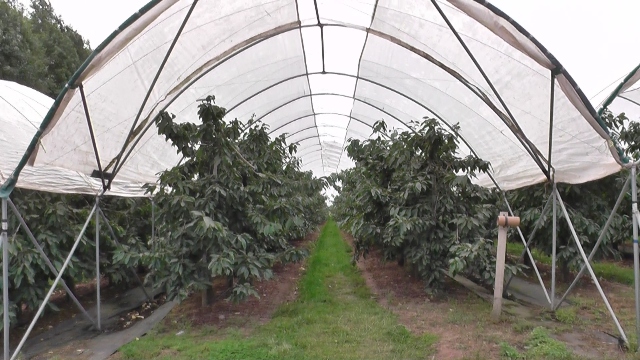
We also looked at the one hectare trial block, where a number of varieties (from early to late) are growing on intensively planted 'super spindles' - the 'trial' planting distances are: 0.5 metre (in the row) x 3 metre (between the rows) & 0.75 metre x 3 metre - a third trial has been planted with 'twin leader' trees.
Below: Super Spindle Cherries in the trial block
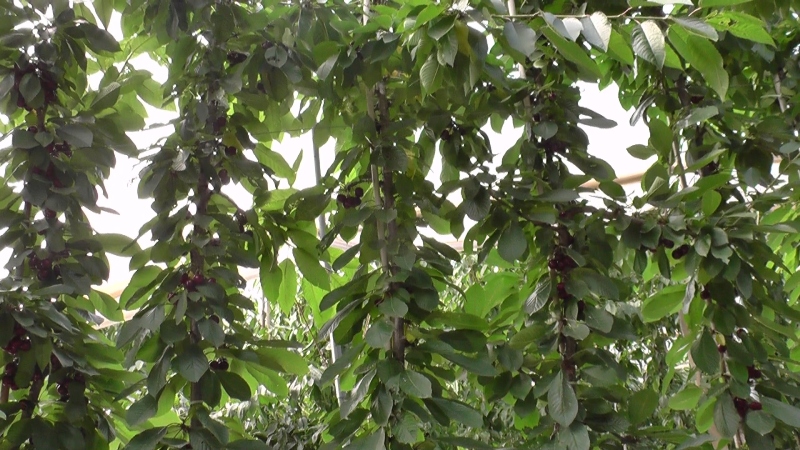
An important aspect of tree management is dealing with the tops, which can get very 'growy' - this is best managed after harvest; the tunnel covers are removed as soon as harvest (for a variety) has finished. This means from late July the process of removing strong growth in the the tops is followed by removal of covers soon after. The process is complete by the end of September.
Detailed pruning of the rest of the tree is carried out in the springtime........
Below: left; the end view of one of the trial block tunnels and right; the tops become very growey and are removed after harvest
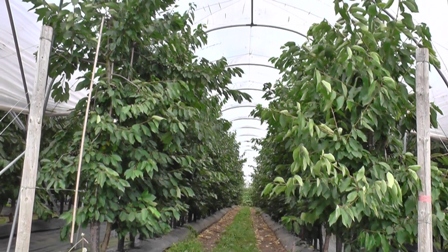
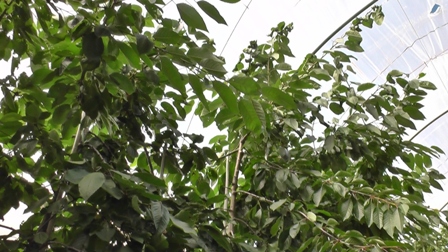
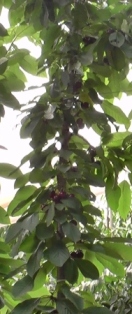 Tree management in the super spindles, requires short fruiting branches (unlike the longer laterals in the standard cherry production tunnels)
Tree management in the super spindles, requires short fruiting branches (unlike the longer laterals in the standard cherry production tunnels)
Emily explained the importance of not allowing the branches to grow to long; the ideal is renewal of the short, downward facing fruiting units ensuring the fruit is growing near to the main stem.
Reflecting back to the springtime: the tunnel covers go on from early March until mid May (depending on the variety) it is not possible to start before then due to windy conditions - blossom time starts in early April.
The trial trees are planted on ridges with irrigation tubes laid beneath the plastic mulch. The ridges aid drainage and create a healthier root zone. To accommodate the taller (super spindle trees) the tunnels have a Y leg with straight extensions pushing the curved tunnel framework higher.
With much taller trees, a motorised platform is used for picking and pruning the higher elements of the trees
Below: left; the Y section ends of the trial tunnels and right; the plastic mulched ridges
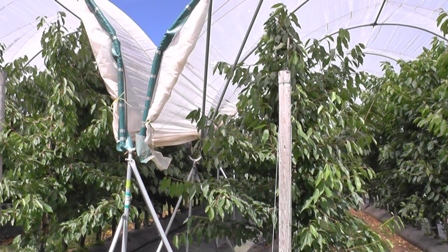
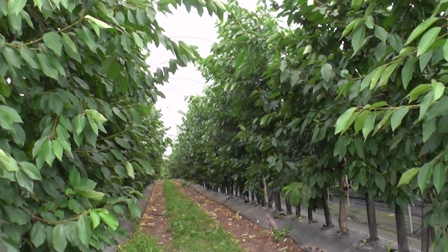
From the cherry production tunnels, the fruit makes a short journey to a 'state of the art' grading line. At a cost running into seven figures, this cherry grader can size and select cherries into the required customer specification and recognise and reject inferior fruits.
Below: left; cherries enter the grading line and right; some hand sorting is required to remove any leaves and separate bunches etc.
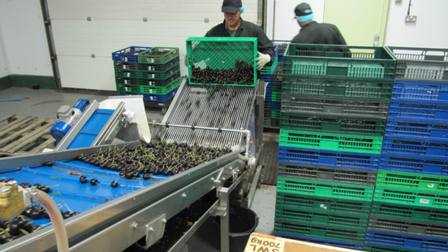
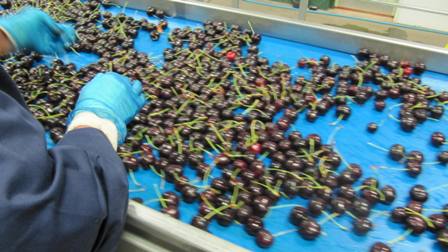
Below: left cherries on the grading line before entry to right; the MAF RODA cherry grader
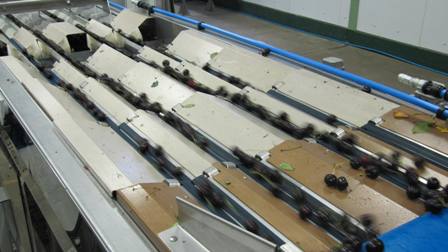
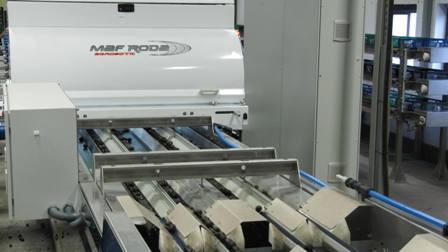
Below: left; the grader transfers images of each cherry and its quality parameters and right; cherries in their designated punnets
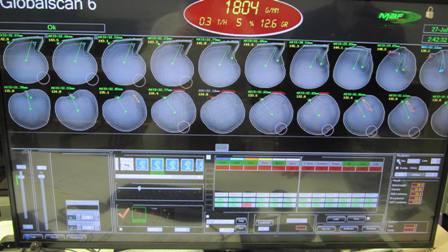
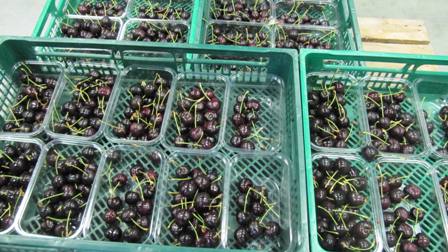
Below: left; cherries on the lidding line and right; lidded and ready for labelling
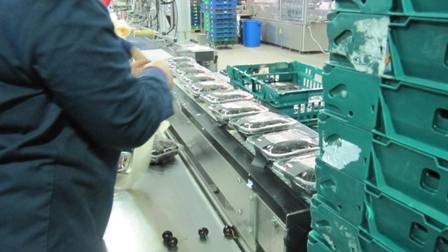
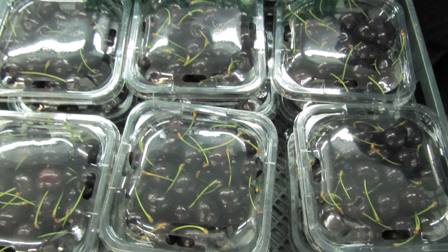
Click on Maf Roda for more information on the cherry grader.
In addition to her role as Manager of Lower Hope Fruit Farm, Emily Livesey is the Chair of the 2019 Under 40's Conference Committee.
Click on Emily Livesey introducing the Lower Hope Concept Orchard - Lower Hope Fruit's Entry for Waitrose Farming Awards.
Below: The 2019 Under 40's Committee with Emily Livesey 3rd from the right in a green dress
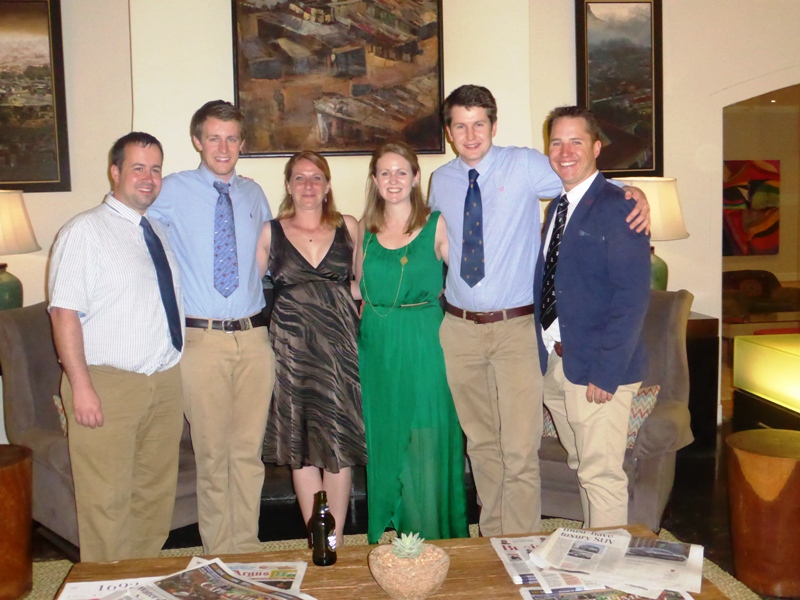
For an extensive look at the Lower Hope Estate - Click on: LOWER HOPE
The English Apple Man's visit to Lower Hope Cherries confirmed its status as a leader of cherry production in the UK....
That's all for this week...........sorry the on-line publication is late (Sunday evening at 10pm)
Take care
The English Apple Man